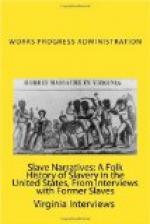I
This collection of slave narratives had its beginning in the second year of the former Federal Writers’ Project (now the Writers’ Program), 1936, when several state Writers’ Projects—notably those of Florida, Georgia, and South Carolina—recorded interviews with ex-slaves residing in those states. On April 22, 1937, a standard questionnaire for field workers drawn up by John A. Lomax, then National Advisor on Folklore and Folkways for the Federal Writers’ Project[1], was issued from Washington as “Supplementary Instructions #9-E to The American Guide Manual” (appended below). Also associated with the direction and criticism of the work in the Washington office of the Federal Writers’ Project were Henry G. Alsberg, Director; George Cronyn, Associate Director; Sterling A. Brown, Editor on Negro Affairs; Mary Lloyd, Editor; and B.A. Botkin, Folklore Editor succeeding Mr. Lomax.[2]
[Footnote 1: Mr. Lomax served from June 25, 1936, to October 23, 1937, with a ninety-day furlough beginning July 24, 1937. According to a memorandum written by Mr. Alsberg on March 23, 1937, Mr. Lomax was “in charge of the collection of folklore all over the United States for the Writers’ Project. In connection with this work he is making recordings of Negro songs and cowboy ballads. Though technically on the payroll of the Survey of Historical Records, his work is done for the Writers and the results will make several national volumes of folklore. The essays in the State Guides devoted to folklore are also under his supervision.” Since 1933 Mr. Lomax has been Honorary Curator of the Archive of American Folk Song, Library of Congress.]
[Footnote 2: Folklore Consultant, from May 2 to July 31, 1938; Folklore Editor, from August 1, 1938, to August 31, 1939.]
On August 31, 1939, the Federal Writers’ Project became the Writers’ Program, and the National Technical Project in Washington was terminated. On October 17, the first Library of Congress Project, under the sponsorship of the Library of Congress, was set up by the Work Projects Administration in the District of Columbia, to continue some of the functions of the National Technical Project, chiefly those concerned with books of a regional or nationwide scope. On February 12, 1940, the project was reorganized along strictly conservation lines, and on August 16 it was succeeded by the present Library of Congress Project (Official Project No. 165-2-26-7, Work Project No. 540).
The present Library of Congress Project, under the sponsorship of the Library of Congress, is a unit of the Public Activities Program of the Community Service Programs of the Work Projects Administration for the District of Columbia. According to the Project Proposal (WPA Form 301), the purpose of the Project is to “collect, check, edit, index, and otherwise prepare for use WPA records, Professional and Service Projects.”




